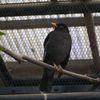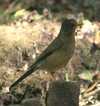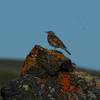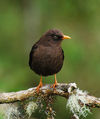Genus Turdus
White-necked Thrush - This thrush is 20½-26 cm long and weighs 40-77 g .
White-collared Blackbird - It is found in Bangladesh, Bhutan, China, India, Myanmar, Nepal and Pakistan. Its natural habitats are subtropical or tropical moist montane forests and subtropical or tropical high-altitude shrubland.
Comoro Thrush - The Comoro Thrush is a species of bird in the Turdidae family. It is found in Comoros and Mayotte. Its natural habitat is subtropical or tropical moist lowland forests.
Grey-winged Blackbird - It is found in Bangladesh, Bhutan, China, India, Laos, Myanmar, Nepal, Pakistan, Thailand, and Vietnam. Its natural habitat is subtropical or tropical moist montane forests.
Seven Islands Thrush - Reaching a length of approximately 23 cm, the Izu Thrush has a distinctive dark plumage, with a black head and tail contrasting with yellow eye-ring and bill, chestnut brown wings, and a rust-red belly. This color pattern often elicits comparisons to the American Robin.
Chiguanco Thrush - The Chiguanco Thrush is a species of bird in the Turdidae family. It is found in Argentina, Bolivia, Chile, Ecuador, and Peru. Its natural habitats are subtropical or tropical high-altitude shrubland and heavily degraded former forest.
Black-breasted Thrush - Its natural habitats are subtropical or tropical dry forests and subtropical or tropical moist montane forests.
Austral Thrush - The Austral Thrush is similar to the European Blackbird also of the genus Turdus, with a yellow bill and feet, a dark brown head, back and wings and a lighter underside. In T. f. falcklandii the underside tends towards ochre, but the smaller T. f. magellanicus is more olive below. The throat of both subspecies is streaked.
Grey-sided Thrush - The species is migratory, breeding in the mountains of north-east China, and migrating to subtropical or tropical moist montane forest in India, Laos, Myanmar, and Thailand.
Turdus flavipes - The Yellow-legged Thrush is a songbird of northern and eastern South America. In recent times, it is increasingly often placed in the genus Turdus again.
Cocoa Thrush - The habitat of this large thrush is dense forest. The nest is a lined bulky cup of twigs low in a tree or treefern. Two to three reddish-blotched greenish-blue eggs are laid and incubated by the female for about 13 days to hatching. The young then fledge in another 13–15 days.
Gray's thrush - It ranges from South Texas to northern Colombia; west and north of the Isthmus of Tehuantepec. It is limited to the Atlantic slope, except for a population around Oaxaca City that probably originates from escaped cagebirds.
Unicoloured Thrush - The Unicoloured Thrush is a species of bird in the Turdidae family. It is endemic to Bolivia.
Hauxwell's Thrush - The Hauxwell's Thrush is a species of bird in the Turdidae family. It is found in Bolivia, Brazil, Colombia, Ecuador, Peru, and Venezuela. Its natural habitats are subtropical or tropical moist lowland forests and subtropical or tropical swamps.
Turdus helleri - The Taita Thrush was previously classified as subspecies of the Olive Thrush , but it is regarded as distinct species since 1985. It reaches a length between 20 to 22 centimetres. Head, breast and upperparts are coloured darkly. The underparts are white and the flanks have a rufous hue. The eyes and the bill exhibit a pale orange coloration. It was named after zoologist Edmund Heller a workmate of the American ornithologist Edgar Alexander Mearns who described this species scientifically in 1913.
Grey-backed Thrush - A captive bred pair laid five eggs, which hatched 14 days after the first egg was laid. The young left the nest 12 days later.
Black-billed Thrush - It is found in Bolivia, Brazil, Colombia, Ecuador, Guyana, Peru, Suriname, and Venezuela.
Red-winged thrush - The Redwing is a bird in the thrush family Turdidae, native to Europe and Asia, slightly smaller than the related Song Thrush.
Black Robin - The Black Thrush is a species of bird in the Turdidae family. It was formerly known as the Black Robin. It is found in El Salvador, Guatemala, Honduras, and Mexico. Its natural habitat is subtropical or tropical moist montane forest.
Lawrence's Thrush - The Lawrence's Thrush is a species of bird in the Turdidae family. It is found in Bolivia, Brazil, Colombia, Ecuador, Peru, and Venezuela. Its natural habitats are subtropical or tropical moist lowland forests and subtropical or tropical swamps.
Pale-breasted Thrush - It is found a wide range of wooded habitats in eastern and northern South America, with localized population in the west.
Turdus ludoviciae - It has a black head and breast, yellow bill, brown back and wings and a grey belly with red sides.
Maranon Thrush - The Marañón Thrush is a species of bird in the Turdidae family. It is found in Ecuador and Peru. Its natural habitats are subtropical or tropical dry forests and subtropical or tropical moist lowland forests.
Common Blackbird - The male of the nominate subspecies, which is found throughout most of Europe, is all black except for a yellow eye-ring and bill and has a rich melodious song; the adult female and juvenile have mainly dark brown plumage. This species breeds in woods and gardens, building a neat, mud-lined, cup-shaped nest. It is omnivorous, eating a wide range of insects, earthworms, berries, and fruits.
Red-breasted thrush - The American Robin or North American Robin It has seven subspecies, but only T. m. confinis in the southwest is particularly distinctive, with pale gray-brown underparts.
Mongolian Song Thrush - A recent molecular study places the Chinese Thrush's closest relatives as the similarly plumaged European species, the Song Thrush and the Mistle Thrush , all three species early offshoots from the main Turdus radiation around the world.
Dusky Trush - This species breeds in open woodland areas; Dusky Thrush, as would be expected, is more tolerant of mountainous and tundra-edge habitats. This species is strongly migratory, wintering south to southeast Asia, principally in China and neighbouring countries. It is a rare vagrant to western Europe.
Sooty Robin - This is an abundant bird of open areas and oak forest edge normally above 2200 m altitude. It builds a heavy grass-lined cup nest in a tree 2-8 m above the ground, and the female lays two unmarked greenish-blue eggs between March and May.
Andean Slaty Thrush - It is found in north-west Argentina, Bolivia, Ecuador and Peru. The subspecies found in north-east Argentina, Paraguay and Brazil is often considered to be a separate species, the Eastern Slaty Thrush .
Bare-eyed Robin - The similar but allopatric Ecuadorian Thrush was formerly considered a subspecies of the Bare-eyed Thrush and named T. n. maculirostris; it is now normally separated as a good species T. maculirostris. It has a narrower eyering and is only found in forest and woodland in western Ecuador and northwestern Peru.
Eyebrowed thrush - It breeds in dense coniferous forest and taiga eastwards from Siberia. It is strongly migratory, wintering south to southeast Asia and Indonesia. It is a rare vagrant to western Europe.
Pale-vented Thrush - It is found in Colombia, Costa Rica, Ecuador, Panama, and Peru. Its natural habitats are subtropical or tropical moist lowland forests, subtropical or tropical moist montane forests, and heavily degraded former forest.
Olivaceous Thrush - Its natural habitats are subtropical or tropical moist lowland forests and subtropical or tropical moist montanes. It is threatened by habitat loss.
Olive Thrush - It can reach a length of 24 cm and a mass of at least 101 grams. The tail and the upperparts are coloured dull olive brown. The belly is white and the rest of the underparts have an orange hue. The throat is speckled with white spots. It can be found in evergreen forests, parks, and gardens. Its diet consists of earthworms, insects, snails, fruits, and spiders.
Pale Thrush - It is 23 cm long. The feet are pale pinkish-brown and the bill is grey above and yellow below. The male is brown above with a blue-grey head and throat. The underparts are pale brown, darker on the flanks and whitish on the belly and undertail-coverts. The flight feathers of the wing are dark grey and the underwing-coverts are grey or white. The tail is dark grey with white tips to the outer feathers. The female is similar to the male but duller with a browner head and pale throat.
African Thrush - African Thrushes are omnivorous, eating a wide range of insects, earthworms and berries. They nest in bushes or similar. They do not form flocks.
Song Thrush - The Song Thrush breeds in forests, gardens and parks, and is partially migratory with many birds wintering in southern Europe, North Africa and the Middle East; it has also been introduced into New Zealand and Australia. Although it is not threatened globally, there have been serious population declines in parts of Europe, possibly due to changes in farming practices.
Fieldfare - It breeds in woodland and scrub in northern Europe and Asia. It is strongly migratory, with many northern birds moving south during the winter. It is a very rare breeder in Great Britain and Ireland, but winters in large numbers in these countries.
Mountain Robin - This is a bird of tall mountain forests and adjacent more open areas and woodland edge. Its preference is for oak with many epiphytes and mosses, normally from 1800 m altitude to the timberline. It descends in flocks as low as 900 m in the wet season.
Porto Rican thrush - The Red-legged Thrush is a species of bird in the Turdidae family. It is found in the Bahamas, Cayman Brac, Cuba, Dominica, the Dominican Republic, Haiti and Puerto Rico. It formerly occurred on the Swan Islands, Honduras. Its natural habitats are subtropical or tropical dry forests, subtropical or tropical moist lowland forests, subtropical or tropical moist montanes, and heavily degraded former forest. This species may be considered the Caribbean counterpart of the American Robin, as it has similar habits, including being a common visitor to gardens and lawns.
Island Thrush - The Island Thrush is a member of the cosmopolitan genus Turdus , one of the most widely distributed bird genera in the world. The taxonomy of the Island Thrush is complex, and has defied attempts to split the group based on the four suspected morphological types. The subspecies Turdus poliocephalus niveiceps from Taiwan represents the most distinct taxon and may be a separate species. This subspecies lives at the northerly range of the species, and is the only one in which the males and females differ in colour. There are also thought to be at least two further subspecies not yet described scientifically, both from the Indonesian island of Sulawesi.
Grand Cayman Thrush - It was general ashy grey with a white underbelly. Undertail coverts and the tips of the outer tail feathers where coloured white too. The bill, the feet, and the naked eye-ring were red. The wing length was 13,5 centimetres and the length of the tail was 11 centimetres. The bill reached a length of 2.4 centimetres and the legs were about 3.8 centimeters long.
Plumbeous-backed Thrush - The Plumbeous-backed Thrush is a species of bird in the Turdidae family. It is found in Ecuador and Peru. Its natural habitats are subtropical or tropical dry forests, subtropical or tropical moist lowland forests, and subtropical or tropical moist montanes.
Grey-headed Thrush - The Chestnut Thrush is a species of bird in the Turdidae family. It is found in Afghanistan, Bhutan, China, India, Laos, Myanmar, Nepal, Pakistan, Thailand, and Vietnam. Its natural habitat is temperate forests.
Red-throated Thrush - The Red-throated Thrush is a migratory Asian species. Its range overlaps with the more westerly-breeding Black-throated Thrush. It is a large thrush with a plain grey back and reddish underwings. The adult male has a red throat. Females and young birds lack the bib, but have black-streaked underparts. This bird species is a very rare vagrant to western Europe.
Rufous-collared Robin - It is endemic to highlands of Middle America, south of the Isthmus of Tehuantepec, occurring in El Salvador, Guatemala, Honduras, and Chiapas state in Mexico. Its closest relative is the American Robin, and like that species, it is found in varied habitats, from towns to forest. It is, however, restricted to highland areas with at least some trees. It is also known as the Rufous-collared Thrush.
Rufous-bellied Thrush - It is one of the most common birds across much of southeastern Brazil, and is well-known there under its local name sabiá-laranjeira. The Rufous-bellied Thrush has been the state bird of São Paulo since 1966. It was proposed as the national bird of Brazil, and was officially chosen in 2002.
Grayson's robin - This species resembles its widespread relative the American Robin in general appearance, but is a bit smaller at 21.5–24 cm long, It is named for the adult's rufous or olive-rufous upper back, which contrasts with the grayish head, nape, and rump. The chest and flanks are also rufous. The belly and undertail coverts are white; the throat is white with many black streaks. The bill and eye-ring are yellow. Females are typically somewhat duller-colored than males. Juveniles, like other juvenile Turdus thrushes, are spotted below; they are browner and have pale flecks above.
Glossy-black Thrush - The Glossy-black Thrush is a species of bird in the Turdidae family.
African Bare-eyed Thrush - The African Bare-eyed Thrush is a species of bird in the Turdidae family. It is found in Ethiopia, Kenya, Somalia, and Tanzania. Its natural habitats are dry savanna and subtropical or tropical dry shrubland.
Ring Ouzel - It is the mountain equivalent of the closely-related Common Blackbird, and breeds in gullies, rocky areas or scree slopes.
Thickell's Thrush - Males of this small thrush have uniform blue-grey upperparts, and a whitish belly and vent. Females and young birds have browner upperparts.
Mistle Thrush - The Mistle Thrush is a member of the thrush family Turdidae.
























